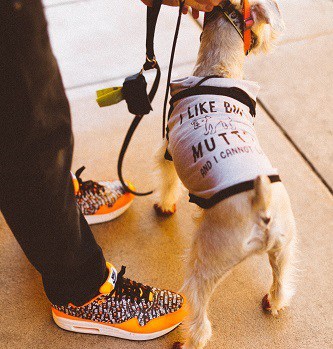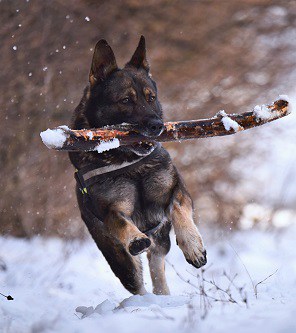As an active person, you probably enjoy physical activity as much as I do. To be honest, running with your dog is the perfect opportunity to have fun with him while working out. Everyone knows that sports are extremely good for both humans and pets. That’s why I love to exercise with my Labrador. But you might wonder how long (or far) you can run safely with your dog!

I recently questioned myself about how many miles my Lab could run with me? Just like you, I know that this intense activity can be awesome to keep us both healthy, active, and happy. On the other hand, I don’t want to take unnecessary risks simply to get in better shape. After some research, I found a lot of useful information about how long or far dogs can run safely. Let me share it with you!
Things like the breed, the energy, the size, and athletic qualities will determine how far you can run with your dog. Normally, every healthy dog can jog around 2 or 3 miles (3.2 to 5 km)! Some natural runners such as Labradors or Huskies can enjoy long runs. Other less active dogs like Bulldogs can’t trot more than 2 miles (3.2 km)!
At the end of your reading, you will know how many miles (or km) approximately your dog is suitable to run. However, this will be unique for each companion. Jogging too long distances can be dangerous for your buddy. Therefore, always make sure to respect your dog’s limits and conditions to find the perfect running distance!
Is Your Dog Suitable To Run?
First of all, you need to make sure that your dog is OK with intense physical activity. Unfortunately, some furballs aren’t suitable to run safely. This is very sad because everyone should have the possibility to enjoy this wonderful canine sport. However, most dogs won’t have issues with regular jogs!
How can you know if your pooch can do more serious running? There are many ways to make sure that he’s suitable for this type of exercise. The easy way is to visit your veterinarian; an expert answer is always valuable. Nonetheless, you can analyze your dog yourself to make sure he’s alright to run rather easily. Let me share with you the main things that can restrict your companion from working out with you!
Consider His Breed!
As always, your canine breed can tell you a lot about him. When I did some research on Labradors, I discover awesome things about my buddy «Marshmallow». That’s why I highly recommend investigating on your dog’s breed to know him well!
Things like why your dog was bred for, his energy level, personality, and much more information about his breed can give you an idea of his running abilities. In general, only very low energy, lazy and inactive types of companions won’t be able to run. Even if each dog is unique, his origin can help you understand if he can run!
Your Dog’s Health Matters!
This is probably the most important to consider before starting any new sports with your dog. Even if you think he’s in perfect health, you can’t be sure at 100%. That’s why it’s highly recommended to visit your vet before changing your companion’s exercise routine. It’s the safest way to know what are your companion’s health conditions!
Depending on the dog breed or their heredity, some animals are more prone to specific problems. For example, active dogs are more likely to develop joint problems. Unfortunately, these structural issues (hip dysplasia, luxating patellas, and arthritis) can hurt your companion while running!
Therefore, if your dog isn’t in good health or shape, jogging with him could be not possible. I’m sure his safety is way more essential than your fitness goals. However, there might be a solution to exercise your buddy while respecting his restrictions. Indeed, you can generally adapt your running type (intensity, distance, etc.) to his conditions and physical capacity!
Make Sure He’s Old Enough, But Not Too Much!
Puppies can’t run because they are still growing. Over-exercising young dogs could hurt them seriously or have permanent bad repercussions. In general, your pup will be fully grown around 12 to 18 months. It can be longer for large breeds or faster for smaller ones. To give you an idea, most dogs will be suitable to run safely after 1 year of age!

Did you know that your buddy can be too old to run? Indeed, senior dogs can be too fragile and not enough in shape to enjoy intense sports. Some very active and athletic companions could run until their golden age. Normally, you should find lower intensity activities for your dog when he’s older than 7 or 8 years!
The Size Is Important!
This might sound weird, but it’s true. Giant and ultra-small dogs are not well suited to run. Very large breeds could have too much pressure on their joints with vigorous exercise. On the contrary, most small companions won’t be able to keep up with your running pace for a long time. Nevertheless, there are exceptions such as Jack Russell Terriers or Rhodesian Ridgebacks that are excellent runners!
Are You Sure Your Pooch Can Run?
No? In case of hesitation, you should talk to your vet. He will answer all of your questions while giving you personal advice. Another option is to give it a try to see how your dog reacts. After one mile (or kilometer) of running without any problem, you can probably guess that he’s suitable to run!
Yes? Awesome, I’m happy for you to have that opportunity of becoming more active with your companion. Now, continue reading to find out how far your dog can run with you!

Be Careful Before Running With These Dogs!
Before going further, there are other more specific conditions that you should take particular attention to. These things won’t restrict your dog from running completely. However, you should be very careful with the type of physical activity that you will do with him. Here are some types of pooches that won’t be ideal to run with!
Injured Dogs!
This might seem obvious, but many people won’t even think about it. Injured dogs take a lot of time before to be fully recovered. Even if your furry friend looks OK, you should visit your vet to make sure that he can slowly get back in shape. Moreover, you need to re-start working out with him gradually to avoid any risk of re-injury!
Overweight Buddies!
Have you ever heard that running is a good way to exercise overweight dogs? Unfortunately, intense physical activity isn’t good for unhealthy companions. Running with extra pounds (or kg) will put too much pressure on your dog’s joints. If he’s overweight, you should try low-energy activities and put him on a healthy diet!
Brachycephalic (or Short-Nosed) Dogs!
This weird word is simply a respiratory issue that short-nosed dogs have. This includes Bulldogs, Pugs, Pitbulls, Shih Tzus, Chihuahuas, Chow Chows, Pekingese Dogs, and some other breeds. That restriction makes them struggle to breathe or regulate their temperature well. However, this health condition doesn’t restrict your dog from running but you need to consider it!
Inexperienced Athletes!
If you don’t exercise your buddy regularly, running might not be the best option. Canine sports are more interesting for active dogs. After some physical conditioning, you may consider running with your companion!

How Long Can Your Dog Run With You?
Now, you probably have a better idea of how well-suited to run your dog is. This will be very important to determine the perfect running distance for both of you. Normally, dogs with excellent running traits (good breed, health, size, etc.) can run farther than others!
The best way to find how long your dog can run is with experimentation. His breed and physical abilities can approximately give you an idea of his maximal or perfect running distance. However, it’s always more accurate to discover your buddy’s physical abilities yourself!
That doesn’t mean to go running as long as your dog can support it. This dangerous method is perfect to hurt or injure him. You should always start gradually while respecting both your limits and conditions. After several short jogs at a slow pace, you could start increasing the running distance very slowly!
You should also be aware that your dog can keep up running even if it’s painful. In theory, he could probably run himself to death principally by overheating. That’s why it’s vital to know your companion boundaries more than he does!
How Many Miles (or Km) Can Your Dog Run?
On average, most dogs can run anywhere from 2 to 5 miles (3.2 to 8 km). This is enough to keep you both healthy and fit with regular jogs. With good training and preparation, you should be able to increase a little bit this distance!
Good Running Partners For Short Distances! (Less Than 3 Miles)
Unfortunately, some sprinters (or lazy dogs) won’t be good endurance runners. However, every healthy dog should be suitable to trot for at least 1 or 2 miles (1.6 or 3.2 km). This doesn’t mean they are not active; maybe they are just very small, built for short bursts, or simply don’t have stamina. On the other hand, many of these breeds can be good short-distance runners!

- Beagles.
- Boxers.
- Doberman Pinschers.
- Poodles.
- Miniature Schnauzers.
- Great Danes.
- Etc.
Dog Breeds That Won’t Be Suitable For Long Runs!

- Bulldogs. (English and French)
- Pugs.
- Rottweilers.
- Dachshunds.
- Corgis.
- Cavalier King Charles Spaniels.
- Yorkshire Terriers.
- Boston Terriers.
- Etc.
Awesome Furry Partners For Medium To Long-Distance Running!
Some dogs that were bred to be active workers can run more than the average. Most sporting, herding, or working breeds are well-suited to jog long distances. These more energetic furballs with good athletic qualities should be able to run around 5 miles (8 km) or more after building up stamina. They may not be able to do this type of physical activity every day, but probably for a few times per week!

- Golden Retrievers.
- Jack Russell Terriers.
- German Shepherds.
- Rhodesian Ridgebacks.
- Brittanys.
- German Shorthaired Pointers.
- Etc.
Some Of The Best Running Dogs To Go As Far As You Want!
For more advanced runners, maybe that 5 miles (8 km) isn’t long enough. However, you should not push your dog too much because even extremely active dogs can’t jog long distances without serious training and preparation. Demi-marathon or marathon are only accessible for a few companions. However, some breeds are suitable for impressive endurance running anywhere from 5 miles to 12 miles (8 to 19 km)!

- Border Collies.
- Labrador Retrievers.
- Australian Shepherds.
- Australian Cattle Dogs.
- Alaskan Huskies or Malamutes.
- Vizslas
- Weimaraners.
- Mix Breed. (of Good Running Dogs!)
- Etc.
After a couple of years building up stamina, a small minority of dogs will withstand running up to 20 miles (32 km) maybe more. However, I don’t recommend jogging such a long distance. Even if some buddies are suitable for endurance running, there’s always a limit. Finding your ideal distance to run between 3 and 10 miles (5 to 16 km) is safer for both of you!
I’ve found a lot of good information on this article from the Pet Health Network [Open In a New Tab] about how many miles can you run with your dog!
What Makes Some Your Dog Good Or Bad For Endurance Running?
You may wonder why certain dogs are better than others for long-distance running. After some research, I found some interesting information. Good running dogs are generally healthy, active, and love that sport. Let me share other characteristics that will influence your buddy’s ability to jog for a long time!
Breed.
As you probably notice, the breed of your dog influences a lot of what you can and can’t do with him. Nonetheless, make sure to not stereotype because every animal is different! Some breeds such as hunting, herding, or working dog were bred to run. Therefore, it’s normal that they perform better than non-natural runners!
Stamina.
This is the most important athletic quality to run long distances. What’s good about it? Stamina is something you can improve with training whatever your dog’s conditions. Unfortunately, some canines won’t be able to improve their running endurance a lot because of physical or medical restrictions!
Experience.
In this world of immediate results, fitness is still something that takes time. The more you run with your dog, the better you both will be. Experienced runners can run longer distances than beginners, it makes sense. Thus, keep in mind that every person or animal that runs regularly will adapt himself to become better!
Other Conditions.
There are so many specific things that could make your buddy run shorter or longer distances. The best advice I can give you is to know your companion very well. Then you will have to respect his conditions while running. With patience, training, and perseverance, I’m sure you can improve your health and fitness!

What Elements Will Determine Your Ideal Running Distance?
Apart from good health, experience, and athletic qualities, some other things can vary the perfect running distance for both of you. Here are some of the elements to take a look at!
Frequency.
You won’t be able to run 5 miles every day with most dogs. That’s why the frequency is really important. Will you jog daily, 2 times a week or every two days? That’s your choice, but assures you to adapt how many miles you run with how often you do it!
Goals.
Everybody will have a different motivation to run with their dog. For example, I enjoy this activity, so my goal is simply to have fun while working out with my Labrador. On the other hand, some more competitive people will maybe train their dog for 5K races. Therefore, your goal will influence how long you want to run together!

5 Things To Know Before Running With Your Dog!
You’re almost ready to go on trails with your buddy. Before letting you go, I have some running tips for you. You can check them quickly, but assure you to keep them in mind. Take a look at these things that every dog owner should be aware of before running with his companion!
Start With Short Jogs!
It’s essential to increase your distance gradually and slowly. Don’t start immediately with 3 to 5 miles (5-8 km) runs. Every dog should try short distances around 1 or 2 miles (1-3 km) at a slow pace before going farther. This safe approach will allow you to teach how to run the right way and smoothly building up for long distances!
Don’t Run In Extreme Temperatures!
You can’t run if it’s too hot or too cold for your dog. In general, your buddy shouldn’t run when the temperature is over 75-80°F (24-27°C). For cold climates, most dogs shouldn’t exercise out below 41°F (5°C). However, it will vary a lot with the fur type and the heat or cold tolerance of your companion!
Bring These Things! (Jogging Gear)
Running with your dog isn’t expensive at all. Moreover, this is probably the most accessible canine sport. Nevertheless, there are some accessories and gear that you need. You must bring some water, a leash, a collar, good running shoes, and waste bags for every jog. For longer distances or canicross, things like a backpack, a travel bowl, some snacks, a hand-free leash, a dog harness, and other equipment could be very interesting!
Pay Attention For Warning Signs!
While running, it’s crucial to look at your dog regularly. If you don’t, how could you possibly know if he’s alright? Be alert to any signs such as unusual heavy painting, ears/tail down, confusion or any other uncommon symptoms. Your dog could need water, some rest or be overheating!
Where & When To Run With Your Dog?
The best place to run with your companion is on soft grounds. Trails made of dirt, grass or any other natural terrain are «Pawsfects». Hard surfaces such as pavement, gravel, asphalt or concrete could hurt your dog!
The best time will depend a lot on your schedule and personality. Early in the morning or late in the evening is usually ideal to jog. The temperature is cooler, and you’re probably available during these periods. Furthermore, dogs love routines, so find when it’s the best time for you and sticks with it!

I highly recommend you to read the 21 dos & dont’s to run with your dog safely!
Last Thoughts About How Many Miles Dogs Can Run!
Finally, it’s time to start or continue running with your dog. Teaching your buddy how to run might take some time, but it will be worth it. The sooner you start, the faster you will enjoy that awesome canine activity!
Jogging regularly anywhere from 2 to 5 miles (3 to 8 km) with your dog is perfect to improve both your health, shape, and life in general. There are so many benefits to doing this activity, and it’s fun. Therefore, I may one day cross your path on running trails. I hope this article helps you find approximately how long you can run with your dog!